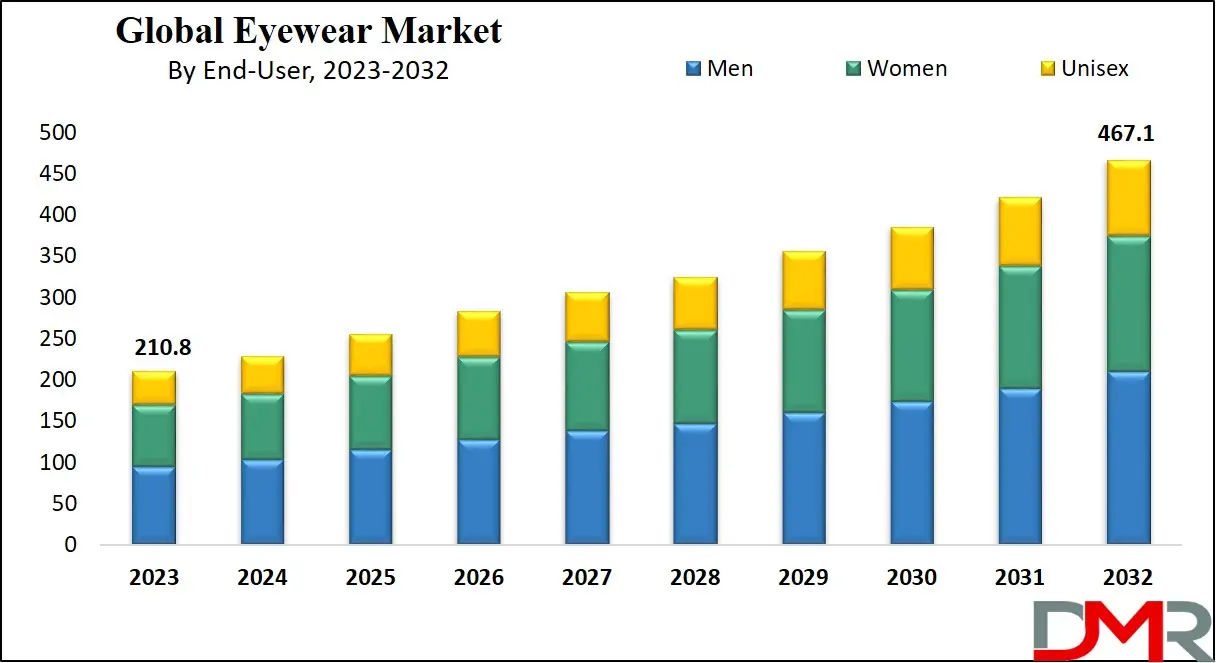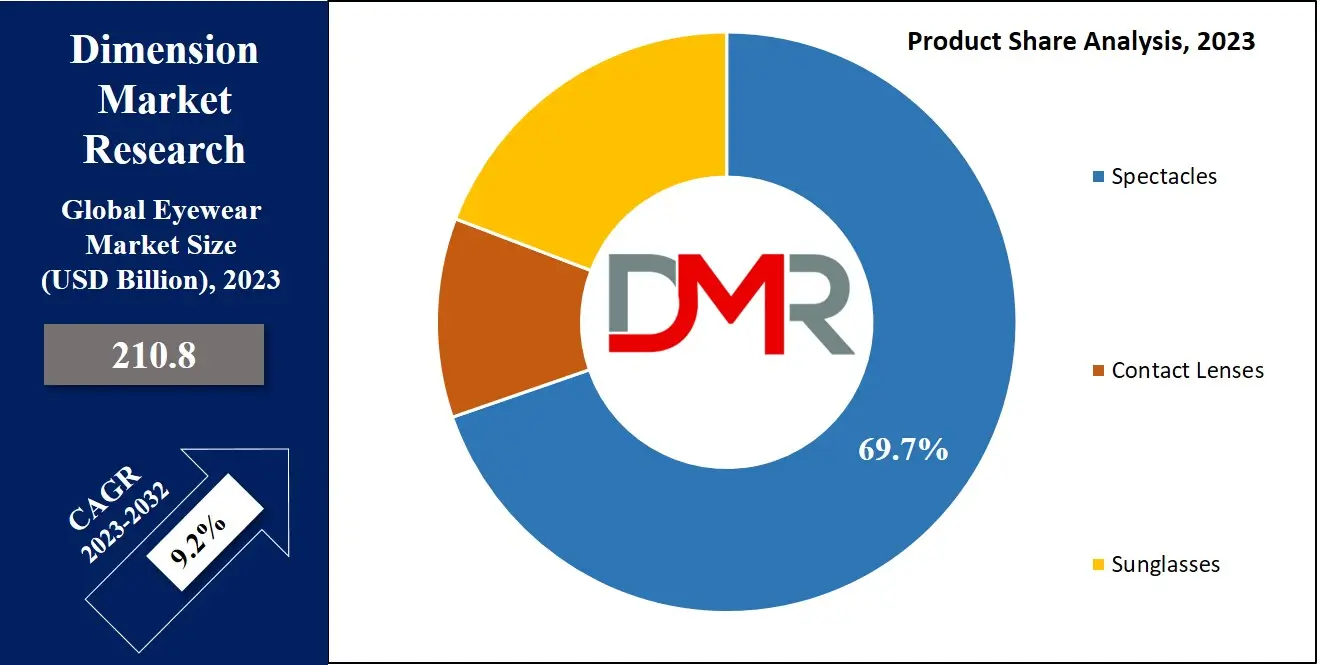
The global eyewear market refers to a collective industry that is involved in the production & distribution of a wide range of products defined for vision correction, fashion, & eye safety, such as prescription glasses, sunglasses, contact lenses, and protective eyewear. This market is segmented into three parts based on product, end-user & distribution chain.
Market Dynamic
The Global Eyewear Market is influenced by factors such as changing fashion trends, increasing awareness about eye
health, new technological advancements in lens material, coating, and the growing demand for online sales where users can try the glasses online by live imaging.
Their dynamics are in constant flux and can significantly affect supply, demand, and pricing.
Nowadays, consumer preferences are shifting and being influenced by evolving tastes, needs & social factors.
Economic conditions like recession, unemployment, and decreasing income levels can affect consumer spending & market growth. As new technological advancements are emerging it can either disrupt the old traditional eyewear market or create a new opportunity for them. Government regulations and policies, such as trade restrictions or environmental standards, can shape the market ecosystem.
Competition among different selling platforms affects the product price range. The overall eyewear market's dynamic is complex and everchanging which requires businesses to adopt strategies efficiently to grow in this market.
Research Scope and Analysis
By Product
In 2023, the spectacle segment asserts its dominance in the Global Eyewear Market, projected to acquire a substantial market share of 69.7% by the end of the year. This remarkable market presence can be attributed to the soaring demand for eyeglasses, driven by the increasing cases of computer vision syndrome (CVS). The increase in cases of computer vision syndrome is directly influenced by the high usage of mobile phones, tablets, & computers.
During the pandemic, the advent of online learning has led to a surge in CVS cases among children. That led to a new trend of anti-glare and anti-fatigue glasses that are becoming famous among consumers as these glasses not only offer vision correction but also serve as stylish accessories, appealing to a broad spectrum of consumers. In sum, this segment's growth in the global eyewear market is a testament to the evolving consumer needs that are influenced by digitalization & new fashion trends.
By Distribution Channel
Distribution channels play a crucial role in how consumers access and purchase eyewear products. In this segment, the offline channels dominate this market. The offline channels include traditional brick-and-mortar retail stores, including optic shops, exclusive stores & departmental stores. Customers can physically visit these establishments to try on the eyeglasses where they can get their eye examinations, and consult with opticians on the spot.
This channel is preferred by consumers who like hands-on, in-person shopping experiences. Many well-established eyewear brands & optical stores operate many chain stores, providing customers with immediate access to eyewear products & services.
By End User
In the eyewear market, when the segmentation is done based on end-users, it is divided into men, women & unisex. This segment is dominated by men due to the wide availability of prescription eyeglasses and sunglasses, perceived as essential tools for vision correction & eye protection.
This market offers an array of styles, materials & designs for the male consumers to choose which act as a major factor behind their major hold in the total market shares. However, this market has significantly evolved over the years as in recent times, there has been a notable shift in the eyewear market as eyewear has become o prominent fashion accessory for both men & women.

Additionally, now in this market, major eyewear manufacturing brands and designers have recognized the significance of female consumers as they have continuously introduced new innovative & stylist collections, which drives the demand for women's eyewear. Also, it is important to acknowledge that the global eyewear market is no longer dominated by one gender, instead, now it grows on diversity, by recognizing the needs of both male and female consumers.
The Global Eyewear Market Report is segmented on the basis of the following
By Product
- Spectacles/Prescription Glasses
- Spectacle Frame
- Spectacle Lenses
- Contact Lenses
- Premium Contact Lenses
- Mass Contact Lenses
- Sunglasses
By Distribution Channel
- Online Channel
- Offline Channel
By End-User
Regional Analysis
In this market,
Europe holds 38.2% of the market shares as it reveals itself as a dominant region with a blend of traditional and innovative trends. The reason behind its dominance is that Europe is the home to many well-established eyewear brands & manufacturers, which often set global fashion trends. In this region, eyewear is not treated as a merely functional necessity but a significant fashion statement. Northern European Nations, with their changing weather patterns, emphasize the importance of protective eyewear, driving the market growth further.

Many Eastern European region shows a growing demand for an affordable eyewear option while Western Europe sees a growth in demand for luxury eyewear. This reason drives the demand for eyewear in this region which leads to a rise in e-commerce and online retail has it also reshaped the European eyewear market, making it easier for consumers to access a wide catalogue of products.
Another region that Europe dominates this market can be attributed to European consumers as they highly value quality, innovation, and fashion which are the main drivers behind the growth of this market.
By Region
North America
Europe
- Germany
- The U.K.
- France
- Italy
- Russia
- Spain
- Benelux
- Nordic
- Rest of Europe
Asia-Pacific
- China
- Japan
- South Korea
- India
- ANZ
- ASEAN
- Rest of Asia-Pacific
Latin America
- Brazil
- Mexico
- Argentina
- Colombia
- Rest of Latin America
Middle East & Africa
- Saudi Arabia
- UAE
- South Africa
- Israel
- Egypt
- Rest of MEA
Competitive Landscape
The competitive landscape of the global eyewear market experiences fierce competition among a few key players. The global eyewear market has many key players who hold a significant portion of the market and are continuously utilizing various inorganic & organic strategies for market expansion and to gain a competitive edge over others. The inorganic strategies these companies use for expansion include the development of new product catalogs and innovation.
Organic strategies deal with partnerships, mergers & acquisitions between companies to improve their product catalog.
Furthermore, these mergers & partnerships further boost their market position and pave the way for the expansion of the market conditions. The major key players in the Global Eyewear Market are Johanson & Johnson Vision Care Inc., CooperVision, Carl Zeiss AG, CIBA VISION, QSpex Technologies, Rodenstock GmbH, Seiko Optical Products Co. Ltd., Warby Parker, Fielmann and others.
Some of the prominent players in the Global Eyewear Market are
- Johanson & Johnson Vision Care Inc.
- Cooper Vision
- Carl Zeiss AG
- CIBA VISION
- De Rigo Vision S.p.A.
- Fielman AG
- HOYA Corporation
- Marclin S.p.A.
- QSpex Technologies
- Rodenstock GmbH
- Seiko Optical Products Co. Ltd.
- Warby Parker
- Other Key Players
COVID-19 Pandemic & Recession: Impact on the Global Eyewear Market:
The COVID-19 pandemic and the economic recession significantly impacted the global eyewear market. The eyewear industry faced various hurdles due to COVID-19 as during those times the economic uncertainties led to a decline in retail sales and disrupted supply chains. Many physical eyewear stores had to close down, affecting the offline market significantly temporarily.
However, the pandemic also accelerated existing trends in the eyewear market. The increased reliance on digital devices due to remote work conditions and online learning led to a surge in demand for blue light-blocking glasses and computer eyewear. Additionally, the fashion-conscious consumer segment continued to drive the demand for stylish eyewear. The import-export restrictions and lockdown led to delays in the demand & supply process that negatively affected the global eyewear market.
Report Details
| Report Characteristics |
| Market Size (2023) |
USD 210.8 Bn |
| Forecast Value (2032) |
USD 467.1 Bn |
| CAGR (2023-2032) |
9.2% |
| Historical Data |
2017 - 2022 |
| Forecast Data |
2023 - 2032 |
| Base Year |
2022 |
| Estimate Year |
2023 |
| Report Coverage |
Market Revenue Estimation, Market Dynamics, Competitive Landscape, Growth Factors and etc. |
| Segments Covered |
By Product (Spectacles/Prescription Glasses, Contact
Lenses and Sunglasses), By Distribution Channel
(Online Channel and Offline Channel), By End-User
(Men, Women and Unisex) |
| Regional Coverage |
North America – The US and Canada; Europe – Germany, The UK, France, Russia, Spain, Italy, Benelux, Nordic, & Rest of Europe; Asia- Pacific– China, Japan, South Korea, India, ANZ, ASEAN, Rest of APAC; Latin America – Brazil, Mexico, Argentina, Colombia, Rest of Latin America; Middle East & Africa – Saudi Arabia, UAE, South Africa, Turkey, Egypt, Israel, & Rest of MEA
|
| Prominent Players |
Johanson & Johnson Vision Care Inc., Cooper Vision,
Carl Zeiss AG, CIBA VISION, De Rigo Vision S.p.A.,
Fielman AG, HOYA Corporation, Marclin S.p.A.,
QSpex Technologies, Rodenstock GmbH, Seiko
Optical Products Co. Ltd., Warby Parker, Fielmann,
and Other Key Players |
| Purchase Options |
We have three licenses to opt for: Single User License (Limited to 1 user), Multi-User License (Up to 5 Users), and Corporate Use License (Unlimited User) along with free report customization equivalent to 0 analyst working days, 3 analysts working days and 5 analysts working days respectively. |